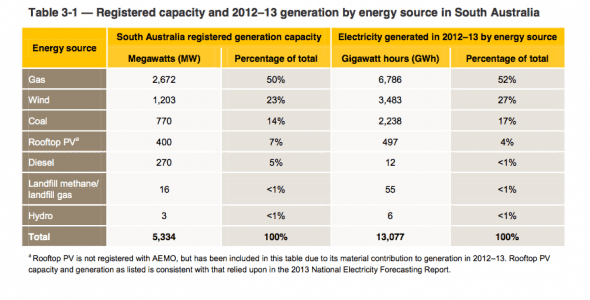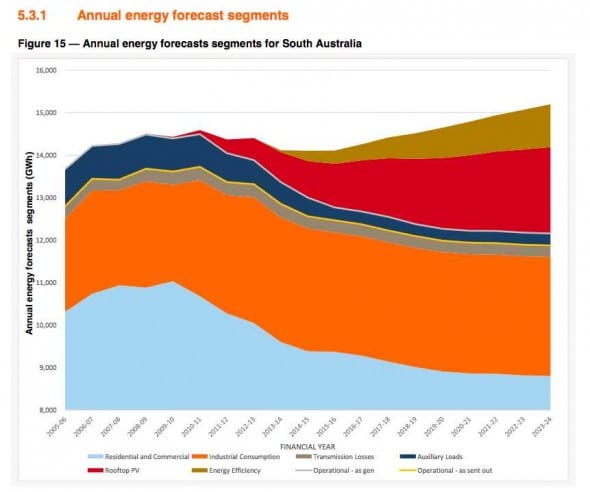South Australia Might Be 1st 100% Renewable Energy Mainland State

Sign up for daily news updates from CleanTechnica on email. Or follow us on Google News!
Originally published on Renew Economy.
The South Australian Labor government gained a lot of credit – and success – when it announced a 33 per cent renewable energy target for the state by 2020.
It seemed very ambitious at the time, but it turns out that it was just a fraction of what is possible: South Australia could become the first mainland state to become 100% renewable. And while that might not transpire as early as 2020, it could happen within a decade, and certainly by 2030.
Imagine that – around 3,000MW of wind generation, rooftop solar on two out of every three homes, widespread battery storage, at least one large-scale solar tower and storage plant (in Port Augusta), and some other utility-scale and community solar farms. And maybe even a little geothermal and ocean energy, as well as some community biomass plants.
So, how does this 100% renewable energy penetration happen?
Let’s start with a few pieces of official data.
 The first is that in 2012/13, according to the Australian Energy Market Operator (see table above), South Australia was already at 31 per cent renewable energy.
The first is that in 2012/13, according to the Australian Energy Market Operator (see table above), South Australia was already at 31 per cent renewable energy.
This was due to its 1200MW of wind farms (nearly half of all wind turbines in the country), and 450MW of rooftop solar (at more than 20 per cent of homes, the highest penetration in the country).
The wind turbines generated 27 per cent of the state’s electricity, with rooftop solar accounting for around 4 per cent.
As we noted in this story, the imminent completion of the 270MW Snowtown 2 wind farm will lift the state’s wind output to around 4,500GWh a year.
This, combined with growth in rooftop solar of more than 700GWh (nearly six per cent) will account for 40 per cent of the state’s electricity demand – beating the 2020 target by more than half a decade.
Next, we look at AEMO’s most recent forecasts (remember, AEMO runs the main grid that serves the eastern states). As we reported earlier this week, AEMO predicts that solar PV generation in the state will triple within a decade to 2,034GWh.
And it expects energy efficiency gains of a further 1,009GWh over the next ten years, which if added to those already implemented (smarter lights, more efficient air-Con, TV and fridges and the like), then the total savings will be around 2,957GWh by 2023/24.
That’s a total of 5,000GWh of demand (energy efficiency and self generation from rooftop solar) subtracted from the state’s grid, or fully one-third of what would be described now as “business as usual”.
It will leave just under 12,000GWh of demand by 2023/24 – the extent of AEMO’s forecasting period. But as AEMO suggests, under its low demand scenario, just 10,687GWh might be needed from the grid in 2023/24.
(This graph below illustrates AEMO’s estimates, although it does not represent past energy efficiency gains).
So, where is the 12,000GWh – or just the 10,687 GWh- going to come from?
Well, as mentioned, there is already the 4,500GWh of wind energy currently in place.
And there are a host of other projects in the pipeline – such as the 275MW Hornsdale wind farm – considered to be one of Australia’s best projects with likely capacity factors of nearly 50 per cent – and the approved 600MW Ceres project in the Yorke Peninsular. AEMO identifies another 13 projects totalling 1,000MW that could be built before 2020.
If the current renewable energy target was to remain in place, Australia as a whole would need to more than double its current installation of wind and solar. If South Australia doubled its wind capacity, it would get to around 9,000GWh by 2020. In that scenario, all but 20 per cent of the fossil fuel generation needed in 2009 has been sidelined.
To get to the extra 3,000GWh (or just 1,687GWh in the low demand scenario) might not be too hard. An extra wind farm of the scale of Hornsdale would account for 1,000GWh.
Just one 110 MW solar tower with storage plant of the type being built in Nevada, and others being planned for Chile, mooted in a smaller capacity for Western Australia, and proposed by many for Port Augusta, could add another 500GWh. And storage will be a critical component of any high renewable grid (as will the continued connection to the rest of the NEM).
Then there is the possibility of ocean energy, of the type that Carnegie Wave Energy is currently building off Perth, or of the hot rock geothermal projects of the type being pursued by Geodynamicsand Petratherm, finally getting connected to the grid.
And there would be enormous prospect for utility-scale solar farms – South Australia has some of the country’s best solar resources. And some biomass too.
As Ron Stobbe, the head of the state’s network operator, SA Power Networks, told a conference in May, it will soon make sense for regional communities – at the edge of the grid – to generate their own electricity through renewables, augment that with storage.
“When it comes to reliability, these alternatives like renewables, going into storage, is actually more reliable than what we can even provide,” Stobbe told RenewEconomy.
“As long as we can top up their storage, it is actually quite a reliable supply. If you look at where it is going to occur first, in my view, I will be in those rural areas.
Ambition is probably the key to this 100% renewable target, but ambition is not unknown in Australia. Tasmania is already close to 100 per cent renewables thanks to its hydro resources, but it would like to boost that, build more wind farms, add a new link and export its surplus to the mainland.
The ACT has a 90 per cent renewable energy target for 2020, which will require around 450MW of generation contracted through a tariff bid at auction. Already, 40MW of solar is being built, and another 200MW of wind energy is coming up for auction in a few months.
Individual councils are also ambitious – Sydney City has a 100 per cent renewable plan by 2030, Lismore City Council wants to do it by 2023. Many others are contemplating it.
So what could go wrong? Well, the removal or the dilution of the RET would slow down progress markedly. According to some insiders, the RET Review panel will recommend (at best) a reduction in the current target of 41,000GWh to around 23,000GWh. That would mean virtually no wind energy being built anywhere in Australia over the next five years.
Certainly, Alinta Energy, the owner of the two coal-fired power stations in Port Augusta that have been sidelined by the growth in renewables, want the target stopped in its tracks. Now. Such an outcome would assist its private equity owners in getting a better price for the planned sale of the company.
The RET Review will also likely recommend the removal of, or a massive cut to, assistance for rooftop solar, which would likely slow down the uptake of household and commercial installations.
In the end, though, it will happen. As Andrew Blakers, of ANU, pointed out last year, just allowing all existing fossil fuel plants to retire at the end of their service lives, and maintaining a solid build-out of renewables in the interim, would see Australia become 100 per cent renewables “by default” by 2040.
The Climate Council’s Martin Rice noted in his recent report that 65 per cent of Australia’s coal-fired power stations will be over 40 years old by 2030. Within a decade, around 50 per cent of Australia’s coal-powered generators will be over 40 years old, with some currently operating stations set to hit 60.
But that is the power of the incumbents. Their opposition to the current renewable target is that it lowers their earnings and forces their plant out earlier than they would like. Alinta’s Playford B power station, is already 50 years old.
The larger Northern power station is 30 years old. It used to provide one-third of the state’s power, but has been sidelined for up to six months at a time due to the growing penetration of wind and solar. By 2023/24 it will be 40 and truly ready to retire, if it hasn’t already.

Chip in a few dollars a month to help support independent cleantech coverage that helps to accelerate the cleantech revolution!
Have a tip for CleanTechnica? Want to advertise? Want to suggest a guest for our CleanTech Talk podcast? Contact us here.
Sign up for our daily newsletter for 15 new cleantech stories a day. Or sign up for our weekly one if daily is too frequent.
CleanTechnica uses affiliate links. See our policy here.
CleanTechnica's Comment Policy

